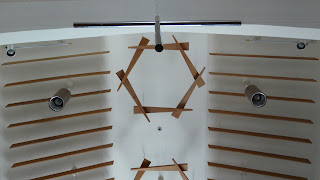Following the fire in St. James Church in Dundas in the late 1970s, the church was re-designed and re-built with the vision toward a modern, open, bright, and affirming future. Although some design points of the time such as the orange floor date it to the time of its construction, far more are timeless.
The churches of the town of Dundas gave St. James a Rood Cross (for more information, please see: http://en.wikipedia.org/wiki/Rood) at the time of the re-dedication. This cross has changed in some ways. At first, and for quite some time, heavy curtains hung behind it, and today, it frames from the south the two modern divisions of the organ, the Swell organ and the Choir organ. The rest of the pipes are at the opposite end of the building in old wooden divisional boxes given to St. James after the closure of a nearby church bearing the same name. A great deal of the artistry of Leslie Smith, organ builder, was in melding the old pipes with new pipes, and the two halves of the organ at either end of the church. For a medium-sized building, this gives the player some unusual opportunities of soundscaping not only the voluntaries but also the hymns in a way that can support beautifully while also accenting certain moments so show the congregants, perhaps, a new vision in the music.
But more on the organ at another time. And there will be more, I promise you. I have spent most of the last several years being an off-again on-again supply and interim organist and throughout being allowed the honour of teaching my students on this most remarkable instrument in this most remarkable building.
As I said in my previous post, I'm looking towards an art show of my photographs mostly taken inside the building. But what can I show the average person that they haven't seen a thousand times before? What, like the organist who can shape a line of music in a new way using this instrument, can I shape to show the viewer a different vantage of the church?
In one teaching block, my second student had broken her wrist and so she wasn't able to practice as much as before. To make the lesson flow, then, I just disappeared for a few minutes to allow her to warm up on the right hand and feet. I wheeled the chair under the great Rood Cross and saw how stunningly different it looked from right underneath, so I put on the brakes of the chair and crawled onto the floor. Laying prostrate but upside-down (i.e. looking up) on the floor I felt like a topsy-turvy ordination candidate, which is not so far from the truth. The images I was seeing in my camera's view-finder moved me greatly, and so I kept playing with angles and shapes, taking essentially the same view over and over and over again. The ceiling of St. James, I should point out, is adorned with stylised crowns of thorns made of strong wood. You will see points of them or whole clusters of them in the photos. Although it won't be obvious, the Rood Cross is what we in the Western world tend to think of as the 'standard' design of the cross, with each arm roughly the same length as from the crossing to the top then about three times as far towards the ground.
And so, as our journey towards Palm Sunday, Holy Week, Maundy Thursday, Good Friday, Holy Saturday, and finally the Feast of the Resurrection: Easter, continues, I hope you may find something new and interesting in these views of the cross.








No comments:
Post a Comment